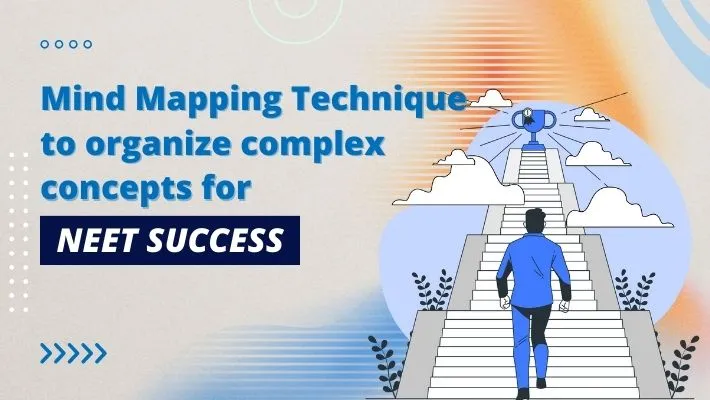
Mind Mapping Technique to organize complex concepts for Neet Success
Mind mapping is a powerful technique to organize complex concepts and enhance understanding, making it a valuable tool for NEET (National Eligibility cum Entrance Test) preparation. Here’s how you can use mind mapping effectively for NEET success:
1. Start with the Central Theme: Begin your mind map by placing the central theme or main topic in the center of the page. This could be a key concept or a broad category relevant to your NEET syllabus.
2. Branch Out with Main Topics:Create main branches radiating from the central theme, representing major topics or subtopics within the subject. For NEET, these could be subjects like Physics, Chemistry, Biology, or specific topics within these subjects.
3. Break Down into Subtopics: From each main branch, further extend sub-branches to represent subtopics or specific concepts. For example, under the Biology branch, you might have sub-branches for Botany and Zoology, and under Chemistry, you could have branches for Organic, Inorganic, and Physical Chemistry.
4. Use Keywords and Images: Instead of writing lengthy sentences, use keywords and brief phrases to capture essential information. Incorporate images or symbols to represent key concepts visually. This aids memory and makes the mind map more engaging.
5. Connect Related Concepts: Use lines or arrows to connect related concepts. This helps illustrate the relationships between different topics and reinforces the interconnected nature of the subjects.
6. Color Code for Clarity: Assign different colors to branches or sections to visually differentiate between subjects or categories. This can enhance clarity and make the mind map more visually appealing.
7. Prioritize Information: Within each branch, prioritize information based on its importance or relevance to the NEET exam. This can help you focus on key concepts and allocate your study time effectively.
8. Review and Update: Periodically review and update your mind map as you progress in your studies. This ensures that it remains a dynamic and accurate representation of your knowledge, helping you identify areas that need further attention.
9. Integrate Practice Questions: Include branches for practice questions, mock exams, and past NEET papers. This allows you to integrate testing and revision strategies directly into your mind map, reinforcing your understanding of various topics.
10. Customize for Personal Learning:Tailor your mind map to suit your learning style. If you’re a visual learner, focus on incorporating more images and colors. If you learn better through words, emphasize keywords and concise text.
By creating a detailed and visually appealing mind map, you can streamline your understanding of complex concepts, identify areas of strength and weakness, and develop an organized approach to your NEET preparation. Mind mapping is a versatile and flexible tool that can be adapted to suit your individual learning preferences and needs.
1. Start with the Central Theme: Begin your mind map by placing the central theme or main topic in the center of the page. This could be a key concept or a broad category relevant to your NEET syllabus.
2. Branch Out with Main Topics:Create main branches radiating from the central theme, representing major topics or subtopics within the subject. For NEET, these could be subjects like Physics, Chemistry, Biology, or specific topics within these subjects.
3. Break Down into Subtopics: From each main branch, further extend sub-branches to represent subtopics or specific concepts. For example, under the Biology branch, you might have sub-branches for Botany and Zoology, and under Chemistry, you could have branches for Organic, Inorganic, and Physical Chemistry.
4. Use Keywords and Images: Instead of writing lengthy sentences, use keywords and brief phrases to capture essential information. Incorporate images or symbols to represent key concepts visually. This aids memory and makes the mind map more engaging.
5. Connect Related Concepts: Use lines or arrows to connect related concepts. This helps illustrate the relationships between different topics and reinforces the interconnected nature of the subjects.
6. Color Code for Clarity: Assign different colors to branches or sections to visually differentiate between subjects or categories. This can enhance clarity and make the mind map more visually appealing.
7. Prioritize Information: Within each branch, prioritize information based on its importance or relevance to the NEET exam. This can help you focus on key concepts and allocate your study time effectively.
8. Review and Update: Periodically review and update your mind map as you progress in your studies. This ensures that it remains a dynamic and accurate representation of your knowledge, helping you identify areas that need further attention.
9. Integrate Practice Questions: Include branches for practice questions, mock exams, and past NEET papers. This allows you to integrate testing and revision strategies directly into your mind map, reinforcing your understanding of various topics.
10. Customize for Personal Learning:Tailor your mind map to suit your learning style. If you’re a visual learner, focus on incorporating more images and colors. If you learn better through words, emphasize keywords and concise text.
By creating a detailed and visually appealing mind map, you can streamline your understanding of complex concepts, identify areas of strength and weakness, and develop an organized approach to your NEET preparation. Mind mapping is a versatile and flexible tool that can be adapted to suit your individual learning preferences and needs.
